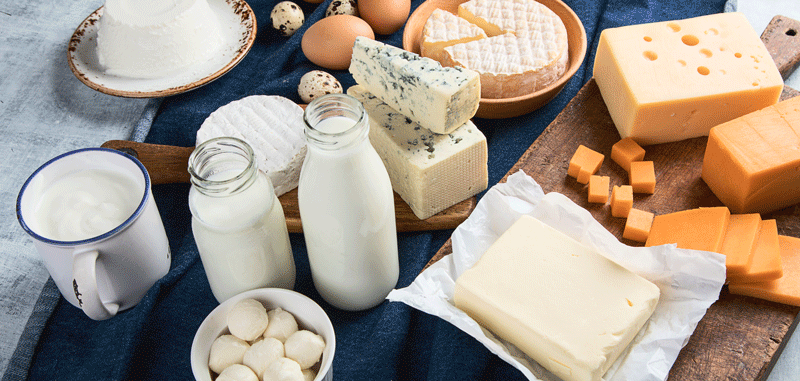
Major points:
- The German Nutrition Society (DGE) recommends a daily protein intake of 0.8 g per kilogram of body weight for adults.
- Biological value (BV) is a key measure of protein quality, showing how efficiently dietary protein can be converted into body protein.
- Neatic places no restrictions on protein intake or protein choices.
How much protein do you need?
According to the German Nutrition Society (DGE), adults aged 19 and older should consume 0.8 g of protein per kilogram of body weight daily. For instance, an 80 kg (176 lb) adult male needs 64 g of protein per day (80 kg x 0.8 g/kg = 64 g).
This target is generally easy to achieve because many foods in a typical Western diet provide ample protein. Animal-based products like meat, fish, eggs, cheese, yogurt, and curd are especially rich in protein. Here is an example of how to meet this daily requirement:
- 150 g of chicken breast (35 g protein)
- 100 g of curd (13 g protein)
- 2 slices of whole-grain bread (6 g protein)
- 1 slice of Emmental cheese (10 g protein)
These four items alone provide the 64 g of protein needed by an 80 kg individual.
The National Consumption Survey II (2008) revealed that protein intake in Germany often exceeds the recommended amount for both men and women. Very few individuals fall below the suggested intake.

What is the biological value (BV)?
The biological value (BV) is a measure of protein quality. It assesses how well dietary protein can be converted into body protein. BV is particularly influenced by essential amino acids, which the body cannot produce on its own. The “limiting amino acid” is the essential amino acid present in the lowest quantity relative to body protein.
A higher BV means the protein source provides essential amino acids in the proportions needed by the body, making it more efficient for building body protein. Proteins that closely resemble the amino acid composition of body protein have a higher BV. For this reason, animal-based proteins often have higher BV than plant-based proteins. Chicken eggs, with a BV of 100, serve as the standard reference because they were once considered the best dietary protein source.
BV of common foods
The table below highlights the BV of various foods, demonstrating that animal-based proteins generally have higher values compared to plant-based sources:
Food | Biological value |
Eggs | 100 |
Pork meat | 85 |
Beef meat | 80 |
Chicken meat | 80 |
Cow`s milk | 72 |
Soy protein | 81 |
Rye flour type 1150 | 78 |
Potatoes | 76 |
Beans | 72 |
Corn | 72 |
Rice | 66 |
Wheat flour type 1050 | 47 |
Can the BV be higher than 100?
Yes! Combining certain protein sources can yield a BV higher than 100, allowing the body to create protein even more efficiently. This is especially important for vegetarians and vegans.

Here are some effective food combinations:
- Potatoes + Eggs: For example, fried potatoes and fried eggs.
- Milk + Grains: Think cheese sandwiches or cereal with milk.
- Milk + Wheat Flour + Eggs: Pancakes or crepes are great options.
- Milk + Potatoes: Creamy mashed potatoes work perfectly.
- Legumes + Meat: Lentil stew with sausage.
- Legumes + Corn: A vegetarian chili sin carne.
Can too much protein be harmful?
There is a common belief that excessive protein intake can harm kidney function. However, for healthy adults, there is currently insufficient evidence to support this claim. According to the European Food Safety Authority (EFSA), consuming up to 1.6 g of protein per kilogram of body weight per day is considered safe for healthy adults. This is double the DGE’s recommendation of 0.8 g of protein per kilogram of body weight per day.
For individuals with reduced kidney function, however, high protein intake may exacerbate their condition and should be monitored.
Protein for athletes
For recreational athletes who exercise 4-5 times a week for about 30 minutes, the standard recommendation of 0.8 g of protein per kilogram of body weight is sufficient.
Competitive athletes or highly active recreational athletes (training 5+ hours per week) may require more protein depending on their sport and training intensity. Even in these cases, dietary sources usually provide enough protein, making supplements like protein shakes unnecessary.

What happens if you do not get enough protein?
If too little protein is supplied in the diet, the body has to react. So it breaks down the body’s own protein from the muscles. The result is that the muscles shrink. For a bodybuilder, this is not a problem at first, because there are enough muscles for the body to use. The situation is different for older or sick people. Because as the muscles become less and less, the risk of bone fractures and frailty increases. If the protein deficiency lasts longer, at some point the body can no longer provide for itself and the metabolism and organ functions can suffer as a result.
What does Neatic recommend concerning protein?
Neatic places no specific limits on protein intake or protein choices. Since the average protein consumption in Germany is above the recommended intake, protein deficiency is unlikely—even for vegetarians and vegans.
In addition to vegetarian and vegan diets, there are other types of diets. Get an overview here!
Bibliography
German Nutrition Society (2021): Selected questions and answers on protein and essential amino acids. Available online at https://www.dge.de/wissenschaft/weitere-publikationen/faqs/protein/?L=0, checked on 2/10/2022.
Elmadfa, Ibrahim; Muskat, Erich; Fritzsche, Doris et al. (2019): Nutritional value-calorie table, The big GU. New edition 2020/21. Munich: GRÄFE UND UNZER Verlag GmbH.
Höfler, Elisabeth; Sprengart, Petra (2018): Practical dietetics. Basics, goals and implementation of nutrition therapy. 2nd, revised and expanded edition. Stuttgart: WVG, Wissenschaftliche Verlagsgesellschaft.
Leitzmann, Claus; Keller, Markus (2020): Vegetarian and vegan nutrition. 4th, completely revised and expanded edition. Stuttgart: Eugen Ulmer publishing house.
Max Rubner Institute (ed.) (2008): National Nutrition Survey II Results Report, Part 2: The nationwide survey on the nutrition of adolescents and adults. Available online at https://www.bmel.de/SharedDocs/Downloads/DE/_Ernaehrung/NVS_ErgebnisberichtTeil2.pdf?__blob=publicationFile&v=2, checked on 1/24/2024.
